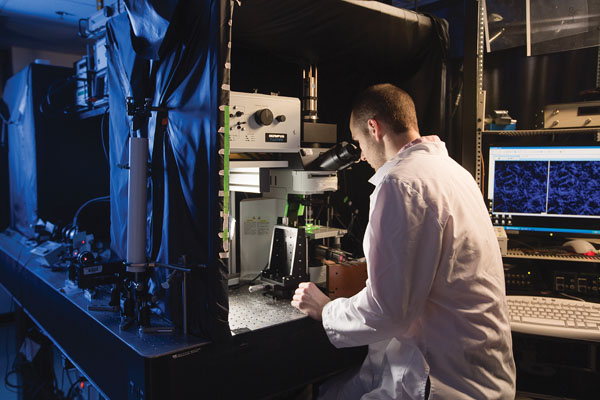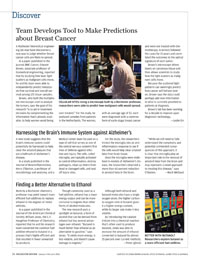In Review
 CELLULAR SITES: Using a microscope built by a Rochester professor, researchers were able to predict how malignant cells would
spread. (Photo: Courtesy of Edwin Brown)
CELLULAR SITES: Using a microscope built by a Rochester professor, researchers were able to predict how malignant cells would
spread. (Photo: Courtesy of Edwin Brown)A Rochester biomedical engineering lab may have discovered a new way to judge whether breast cancer cells are likely to spread.
In a paper published in the journal BMC Cancer, Edward Brown, associate professor of biomedical engineering, reported that by studying how laser light scatters as malignant cells move, he and his team were able to independently predict metastasis-free survival and overall survival among 125 tissue samples.
Brown, who built the multiphoton microscope used to analyze the tumors, says the goal of his research “is to aid in treatment decisions by complementing the information that’s already available, to help women avoid being over-treated.” For the study, he analyzed samples from patients in the Netherlands. The women, with an average age of 52, each were diagnosed with a common form of early-stage breast cancer and were not treated with chemotherapy. Scientists followed the cases for 15 years and correlated the outcomes to the optical signature of each tumor.
Brown’s microscope shines lasers on cancerous tissue and then allows scientists to study how the light scatters as malignant cells move.
Because the scattered light patterns can seemingly predict how cancer will behave later on, Brown says the data could perhaps add new information to what is currently provided to patients at diagnosis.
Brown’s lab has been working for a decade to improve upon diagnostic technology.
—Leslie Orr
Harnessing the Brain’s Immune System against Alzheimer’s
A new study suggests that the brain’s immune system could potentially be harnessed to help clear the amyloid plaques that are a hallmark of Alzheimer’s disease.
In a study published in the Journal of Neuroinflammation, Kerry O’Banion, a professor of neurobiology and anatomy, and a Medical Center team focused on a type of cell that serves as one of the central nervous system’s first lines of defense against infection and injury. The cells, called microglia, are typically activated to control inflammation, destroy pathogens, clean up debris from dead or damaged cells, and seal off injury sites.
For the study, the researchers tricked the microglia into an anti-inflammatory response to see if the cells would help clear amyloid beta from brain tissue.
Once the microglia were mobilized in models of Alzheimer’s disease, the researchers observed a more than 60 percent reduction in amyloid beta in the brain.
“While we still need to fully understand the complexity and potential unintended consequences of this approach, it is clear that microglia play an important role in the removal of amyloid beta from the brain and may represent a novel approach to treating this disease,” says O’Banion. —Mark Michaud
Finding a Better Alternative to Ethanol
 BETTER WITH BUTANOL? Researchers explore butanol as a more efficient fuel additive. (Photo: iStock)
BETTER WITH BUTANOL? Researchers explore butanol as a more efficient fuel additive. (Photo: iStock)Work by a Rochester chemistry professor may point toward more efficient fuel additives to replace ethanol in the engines of motor vehicles.
In a paper published in the Journal of the American Chemical Society, William Jones, the C. F. Houghton Professor of Chemistry, reported that he and his research team converted the common fuel additive ethanol to butanol in a process that’s highly efficient and that resulted in fewer unwanted by-products.
Though commonly used as a fuel additive, ethanol has a lower energy output and can be more corrosive to engines than other forms of alcohol molecules.
The new research puts a spotlight on butanol, a form of alcohol that can be derived from ethanol but has several advantages over ethanol. “Butanol is much better than ethanol as an alternative to gasoline,” says Jones. “It yields more energy, is less volatile, and doesn’t cause damage to engines.”
Although both ethanol and butanol molecules have a single oxygen atom, the higher carbon-to-oxygen ratio in butanol gives it a higher energy content, while its larger size make it less volatile.
By introducing the catalyst iridium into a chemical reaction that’s often used to produce butanol, Jones was able to increase the amount of ethanol converted to butanol by almost 25 percent over current methods.
—Peter Iglinski
Data Mining Instagram: Teenage Drinking Patterns
Could Instagram offer a novel way of monitoring teen drinking habits?
A team of researchers from Rochester report that the data behind the popular photo-oriented social media application can expose patterns of underage drinking more cheaply and faster than conventional surveys and can help uncover important demographic information about teen consumption.
The researchers say they hope that exposing the patterns could help lead to more effective intervention.
Jiebo Luo, a professor of computer science, and colleagues presented their work at the 2015 IEEE International Conference on Big Data in Santa Clara, California.
Studying the social media behavior of underage drinkers who “are willing to share their alcohol consumption experience” in social media allows researchers to observe the activity passively in an “undisturbed state,” the team notes.
Using techniques they pioneered that teach computers to extract information from images on the Internet, Luo and his team analyzed the profile faces of Instagram users to get sufficiently accurate guesses for age, gender, and race.
The researchers found that underage alcohol consumption, as with adults, happens more on weekends and holidays and at the end of the day. They found no strong bias toward one gender for alcohol consumption—the activity matched the gender ratio of Instagram users.
—Leonor Sierra
Surprise! It’s Pi!

Rochester scientists have found further proof of pi’s omnipresence in math and science.
In a paper published in the Journal of Mathematical Physics, Tamar Friedmann, a visiting assistant professor of mathematics, and Carl Hagen, a professor of physics, reported that they found the famous mathematical constant lurking in a quantum mechanics formula for the energy states of the hydrogen atom.
The calculations uncovered a classic 17th-century formula for pi, known as the Wallis formula, that defines pi as the product of an infinite string of ratios made up of integers.
“The value of pi has taken on a mythical status, in part, because it’s impossible to write it down with 100 percent accuracy,” says Friedmann, “It cannot even be accurately expressed as a ratio of integers, and is, instead, best represented as a formula.”
Through a series of calculations, the two were able to obtain values for a series of energy states and compare those values with the values obtained by Danish physicist Niels Bohr almost a century ago. By comparing the ratio of Bohr’s values to how the values obtained with their calculations changed as higher and higher energy levels were taken into account, they found that the ratio yielded—effectively—the Wallis formula for pi.
Mathematician Moshe Machover of King’s College London calls the finding a “cunning piece of magic.”
“This derivation of pi is a surprise of the familiar, much like a magician’s trick,” says Machover. “A child who sees a trick done for the first time may be only surprised. But an adult, who has seen numerous tricks over the years, experiences both surprise and familiarity.” —Peter Iglinski
 Xxxxxx Xxxxxxx. (Photo: Adobe Stock)
Xxxxxx Xxxxxxx. (Photo: Adobe Stock)Hark! What’s That Distance?
It’s an axiom of weather watching that you can count the seconds between a lightning flash and the rumble of thunder to estimate your distance from the atmospheric source of the light.
But new Rochester research indicates that your brain can also detect and process sound delays that are too short to be noticed consciously and that the human brain uses such unconscious information to make finely tuned adjustments when estimating distances.
In a study published in PLOS One, Duje Tadin, associate professor of brain and cognitive sciences, and a team of researchers reported that humans can unconsciously notice and make use of sound delays as short as 40 milliseconds, about the time it takes for a sound to travel 40 feet.
In experiments using projected three-dimensional images, the researchers found that people consistently calibrated the perceived distance of an object if it was connected to an audible sound, coordinating both senses to make careful adjustments to understand what they were seeing.
“Much of the world around us is audiovisual,” Tadin says. “Although humans are primarily visual creatures, our research shows that estimating relative distance is more precise when visual cues are supported with corresponding auditory signals. Our brains recognize those signals even when they are separated from visual cues by a time that is too brief to consciously notice.”
—Monique Patenaude

